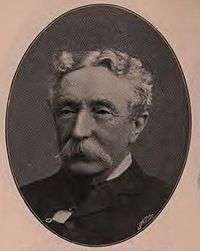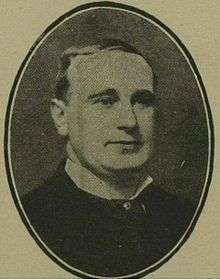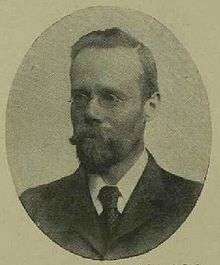Radcliffe-cum-Farnworth (UK Parliament constituency)
Radcliffe-cum-Farnworth was a parliamentary constituency centred on the towns of Radcliffe and Farnworth in Lancashire. It returned one Member of Parliament (MP) to the House of Commons of the Parliament of the United Kingdom, elected by the first past the post system.
| Radcliffe-cum-Farnworth | |
|---|---|
| Former constituency for the House of Commons | |
| 1885–1918 | |
| Number of members | one |
| Replaced by | Heywood and Radcliffe, Farnworth |
| Created from | South East Lancashire |
History
This area had previously been represented as part of South East Lancashire division. Under the Redistribution of Seats Act 1885, the constituency was created for the 1885 general election and was abolished for the 1918 general election.
Boundaries
The South East Lancashire, Radcliffe-cum-Farnworth Division was defined in the 1885 legislation as consisting of the parishes of Farnworth, Kearsley, Little Hulton and Pilkington (including Whitefield and Unsworth) and the parish of Radcliffe except the area in the Municipal Borough of Bury.[1][2]
At the next redistribution of seats in 1918, the constituency was split between two new seats: Farnworth (which included Little Hulton and Kearsley) and Heywood and Radcliffe (which took in Unsworth and Whitefield).[3]
Members of Parliament
| Election | Member | Party | |
|---|---|---|---|
| 1885 | Robert Leake | Liberal | |
| 1895 | John James Mellor | Conservative | |
| 1900 | Theodore Taylor | Liberal | |
| 1918 | constituency abolished: see Heywood and Radcliffe & Farnworth | ||
Elections
| Decades: |
Elections in the 1880s
| Party | Candidate | Votes | % | ± | |
|---|---|---|---|---|---|
| Liberal | Robert Leake | 5,092 | 52.7 | N/A | |
| Conservative | William Hulton | 4,579 | 47.3 | N/A | |
| Majority | 513 | 5.4 | N/A | ||
| Turnout | 9,671 | 92.7 | N/A | ||
| Registered electors | 10,433 | ||||
| Liberal win (new seat) | |||||
| Party | Candidate | Votes | % | ± | |
|---|---|---|---|---|---|
| Liberal | Robert Leake | 4,695 | 50.7 | -2.0 | |
| Conservative | Frederick Milner | 4,559 | 49.3 | +2.0 | |
| Majority | 136 | 1.4 | -4.0 | ||
| Turnout | 9,254 | 88.7 | -4.0 | ||
| Registered electors | 10,433 | ||||
| Liberal hold | Swing | -2.0 | |||
Elections in the 1890s

| Party | Candidate | Votes | % | ± | |
|---|---|---|---|---|---|
| Liberal | Robert Leake | 4,999 | 50.5 | -0.2 | |
| Conservative | John James Mellor | 4,904 | 49.5 | +0.2 | |
| Majority | 95 | 1.0 | -0.4 | ||
| Turnout | 9,903 | 92.7 | +4.0 | ||
| Registered electors | 10,686 | ||||
| Liberal hold | Swing | -0.2 | |||

| Party | Candidate | Votes | % | ± | |
|---|---|---|---|---|---|
| Conservative | John James Mellor | 5,523 | 52.9 | +3.4 | |
| Liberal | George Pollard | 4,923 | 47.1 | -3.4 | |
| Majority | 600 | 5.8 | N/A | ||
| Turnout | 10,446 | 92.8 | +0.1 | ||
| Registered electors | 11,259 | ||||
| Conservative gain from Liberal | Swing | +3.4 | |||
Elections in the 1900s

| Party | Candidate | Votes | % | ± | |
|---|---|---|---|---|---|
| Liberal | Theodore Taylor | 5,497 | 50.3 | +3.2 | |
| Conservative | J.C. Cross | 5,437 | 49.7 | -3.2 | |
| Majority | 60 | 0.6 | N/A | ||
| Turnout | 10,834 | 89.3 | -3.5 | ||
| Registered electors | 12,244 | ||||
| Liberal gain from Conservative | Swing | +3.2 | |||
| Party | Candidate | Votes | % | ± | |
|---|---|---|---|---|---|
| Liberal | Theodore Taylor | 6,719 | 56.8 | +6.5 | |
| Conservative | S. Musgrave | 5,117 | 43.2 | -6.5 | |
| Majority | 1,602 | 13.6 | +13.0 | ||
| Turnout | 11,836 | 90.0 | +0.7 | ||
| Registered electors | 13,151 | ||||
| Liberal hold | Swing | +6.5 | |||
Elections in the 1910s
| Party | Candidate | Votes | % | ± | |
|---|---|---|---|---|---|
| Liberal | Theodore Taylor | 7,367 | 55.8 | -1.0 | |
| Conservative | Edward White | 5,827 | 44.2 | +1.0 | |
| Majority | 1,540 | 11.6 | -2.0 | ||
| Turnout | 93.9 | +3.9 | |||
| Registered electors | 14,046 | ||||
| Liberal hold | Swing | -1.0 | |||
| Party | Candidate | Votes | % | ± | |
|---|---|---|---|---|---|
| Liberal | Theodore Taylor | 6,721 | 53.1 | -2.7 | |
| Conservative | Edward Bagley | 5,937 | 46.9 | +2.7 | |
| Majority | 784 | 6.2 | -5.4 | ||
| Turnout | 12,658 | 90.1 | -3.8 | ||
| Registered electors | 14,046 | ||||
| Liberal hold | Swing | -2.7 | |||
General Election 1914/15:
Another General Election was required to take place before the end of 1915. The political parties had been making preparations for an election to take place and by the July 1914, the following candidates had been selected;
- Liberal: Theodore Taylor
- Unionist:
References
- 1885 c.23 sch.7
- Boundary Commissioners for England and Wales (1885). "South East Lancashire, New Divisions of County (Map)". Report of the Boundary Commissioners for England and Wales. londonancestor.com. Retrieved 2008-09-28.
- F A Youngs Jr., Guide to the Local Administrative Units of England, Vol. II: Northern England, London, 1991
- British Parliamentary Election Results 1885-1918, FWS Craig
Sources
- South Lancashire constituencies map, including Radcliffe-cum-Farnworth.
- Leigh Rayment's Historical List of MPs – Constituencies beginning with "R" (part 1)